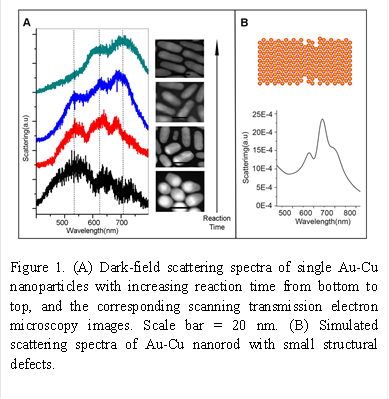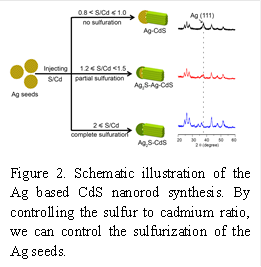Reports: DNI554004-DNI5: Probe Nanoscale Catalytic Sites with Surface-Enhanced Raman Scattering Using Core/Shell Nanoparticles
Jing Zhao, PhD, University of Connecticut
1. Objectives and primary findings:
The objective of the proposal is to develop metal alloy and hybrid metal-semiconductor nanorods as catalysts and to understand the how the properties of these nanorods depend on their structures. In the Au-Cu alloy system, we found that atomic level structural defects formed during Au-Cu nanorod growth significantly affect their plasmonic properties. In the hybrid Ag-metal chalcogenide system, by careful control of the sulfurization of Ag, the nanorods showed improved photocatalytic performance towards dye degradation.
2. Research Achievements:
2.1 Structural defects induced plamson peak splitting in bimetallic Au-Cu nanorods
 Single particle level study of the bimetallic
nanoparticle growth provides valuable information that is usually hidden in
ensemble measurements, helping to improve the understanding of reaction
mechanism and overcome the synthetic challenges. In this study, we monitored
the plasmonic properties of the single AuCu3 nanorods
during a seeded synthesis. Briefly, Au nanocrystals were pre-synthesized and
used as seeds. After copper precursor iwas injected,
samples were acquired at different reaction times during AuCu3 nanorod synthesis and single nanoparticles from each sample
were analyzed. Scanning transmission electron microscopy images in Figure 1A
showed that when reaction time was increased, the nanoparticles transformed
from a quasi-rod with separated Au and Cu phase to an Au-Cu rod. Surprisingly,
multiple scattering peaks were observed in the scattering spectra of majority
of the Au-Cu nanorods acquired at different reaction
times, which was not found in monometallic nanorods.
With the aid of electrodynamics modeling, we found that atomic level surface
defects in AuCu3 alloy nanorods cause
their plasmon band to split. From the plot in Figure 1B, small well like
defects on the surface of the nanorod of 0.5 nm in
width and 1-1.5 nm in depth lead to multiple scattering peaks of the nanorod. The studies suggest that small structural defects
of bimetallic nanorods are key factors regulating
their plasmonic properties.
Single particle level study of the bimetallic
nanoparticle growth provides valuable information that is usually hidden in
ensemble measurements, helping to improve the understanding of reaction
mechanism and overcome the synthetic challenges. In this study, we monitored
the plasmonic properties of the single AuCu3 nanorods
during a seeded synthesis. Briefly, Au nanocrystals were pre-synthesized and
used as seeds. After copper precursor iwas injected,
samples were acquired at different reaction times during AuCu3 nanorod synthesis and single nanoparticles from each sample
were analyzed. Scanning transmission electron microscopy images in Figure 1A
showed that when reaction time was increased, the nanoparticles transformed
from a quasi-rod with separated Au and Cu phase to an Au-Cu rod. Surprisingly,
multiple scattering peaks were observed in the scattering spectra of majority
of the Au-Cu nanorods acquired at different reaction
times, which was not found in monometallic nanorods.
With the aid of electrodynamics modeling, we found that atomic level surface
defects in AuCu3 alloy nanorods cause
their plasmon band to split. From the plot in Figure 1B, small well like
defects on the surface of the nanorod of 0.5 nm in
width and 1-1.5 nm in depth lead to multiple scattering peaks of the nanorod. The studies suggest that small structural defects
of bimetallic nanorods are key factors regulating
their plasmonic properties.
We speculate that the defects formed in the bimetallic nanorods due to the alloy process. Bimetallic alloy nanorods formation involves diffusing and mixing of two metals. Since the two metals in their pure state have different properties such as atom size, reduction potential, lattice constant, surface energies, it is challenging for them to form perfect crystals. In our study, the Cu atoms were deposited on one side of the Au seed before Au and Cu diffused into stable alloy phase. In the diffusing process, the vacancy sites at bimetallic interface before alloying evolve to the surface causing defects mostly on the surfaces of the nanorods. We will pursue further studies on the defect formation mechanism and how they affect the catalytic performance of the bimetallic nanorods.
2.2 Synthesis of Ag-based metal chalcogenide nanorods and their photocatalytic properties

 Hybrid metal-semiconductor nanostructures are
promising candidates for photocatalytic applications because of the efficient
charge separation in the nanostructure. Silver nanocrystals can be used as
seeds to synthesize hybrid nanostructures, providing great optical and
electronic properties. But they are not much explored because they tend to get
oxidized or sulfurized. Here, we report a general protocol for
synthesizing Ag based hybrid metal chalcogenide nanorods
using the complex of oleylamine and chalcogenide as
precursors. This method allows for the epitaxial growth of metal chalcogenides
without sulfurization of Ag seeds by controlled release of chalcogenide in the
reaction process. When proper sulfur precursor and reaction temperature were
applied, the sulfur could be slowly released during the nanorod
growth. The scheme is Figure 2 shows that when changing the sulfur to cadmium
ratio, we can control the sulfurization of the Ag seeds.
Hybrid metal-semiconductor nanostructures are
promising candidates for photocatalytic applications because of the efficient
charge separation in the nanostructure. Silver nanocrystals can be used as
seeds to synthesize hybrid nanostructures, providing great optical and
electronic properties. But they are not much explored because they tend to get
oxidized or sulfurized. Here, we report a general protocol for
synthesizing Ag based hybrid metal chalcogenide nanorods
using the complex of oleylamine and chalcogenide as
precursors. This method allows for the epitaxial growth of metal chalcogenides
without sulfurization of Ag seeds by controlled release of chalcogenide in the
reaction process. When proper sulfur precursor and reaction temperature were
applied, the sulfur could be slowly released during the nanorod
growth. The scheme is Figure 2 shows that when changing the sulfur to cadmium
ratio, we can control the sulfurization of the Ag seeds.
The synthetic method is demonstrated to be widely applicable for organic phase metal chalcogenide nanorod growth, including CdS, ZnS, MnS, and CdSe. Moreover, the hybrid nanorods without sulfurization of the Ag seeds exhibit significantly improved photocatalytic activity, due to the efficient charge separation in these materials. Figure 3 shows the methyl orange (MO) degradation under light irradiation with and without the presence of photocatalysts. Ag-CdS nanorods showed higher catalytic activity compared to Ag2S-CdS nanorods or a mixture of Ag and CdS nanocrystals.
3. Educational Impact:
One postdoctoral scholar, one graduate student, and one undergraduate student were involved in the projects. Postdoc Dr. Shutang Chen performed nanorod synthesis, electron microscopy imaging and X-ray diffraction analysis to study the composition and structure of the nanomaterials. He also performed photocatalytic measurements of dye degradation. Graduate student Sravan Thota carried out the single particle studies of the plasmonic properties of Au-Cu nanorods. Undergraduate student, Gabriella Reggiano, learned how to synthesize hybrid metal-semiconductor nanorod and helped Dr. Shutang Chen to optimize the synthesis. Postdoc and students involved in these projects received interdisciplinary training in nanomaterial synthesis, structural characterization and optical analysis. They also disseminated research findings in scientific publications and presentations in academic conferences.











